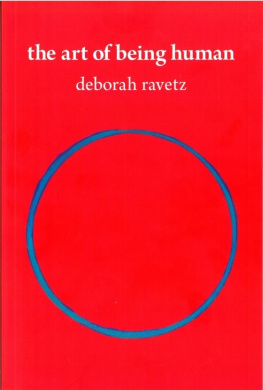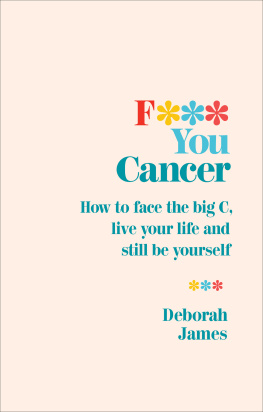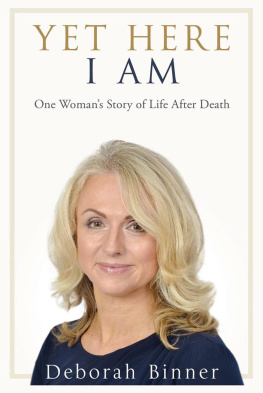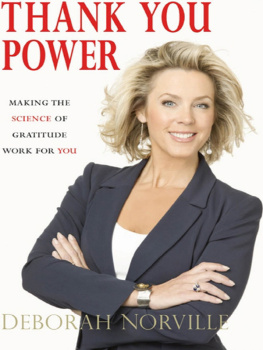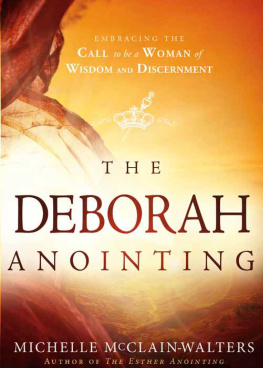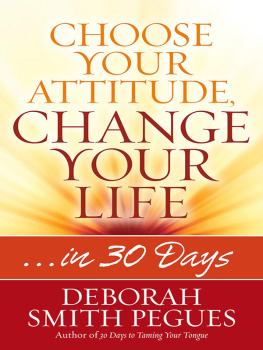
The Art of Being Human
Deborah Ravetz

Jessica Kingsley Publishers
London and Philadelphia
First published in 2017
by Jessica Kingsley Publishers
73 Collier Street
London N1 9BE, UK
and
400 Market Street, Suite 400
Philadelphia, PA 19106, USA
www.jkp.com
Copyright Deborah Ravetz 2016, 2017
Foreword copyright Adam Kahane 2016, 2017
The cover image is for illustrative purposes only, and any person featuring is a model.
All rights reserved. No part of this publication may be reproduced in any material form (including photocopying, storing in any medium by electronic means or transmitting) without the written permission of the copyright owner except in accordance with the provisions of the law or under terms of a licence issued in the UK by the Copyright Licensing Agency Ltd. www.cla.co.uk or in overseas territories by the relevant reproduction rights organisation, for details see www.ifrro.org. Applications for the copyright owners written permission to reproduce any part of this publication should be addressed to the publisher.
Warning: The doing of an unauthorised act in relation to a copyright work may result in both a civil claim for damages and criminal prosecution.
Library of Congress Cataloging in Publication Data
A CIP catalog record for this book is available from the Library of Congress
British Library Cataloguing in Publication Data
A CIP catalogue record for this book is available from the British Library
eISBN 9781784504373
For my mother and father who gave me life
For my husband and my friends
who gave me a harbour
About the Author
Deborah Ravetz was born in Zambia in 1957 and left Africa ten years later. Since then she has lived in both Britain and Germany. She has studied art, philosophy and literature as part of her quest to understand what it means to be human. She sees the whole realm of art and ideas in this light; they embody our attempt to live deeply.
She works as a lecturer specialising in Art and the Development of Consciousness, and also as a painter and a Social Sculpture practitioner. What this is will become clear after reading this book.
In her early thirties she became aware of how very few people love their work. Out of this she developed a method of helping people explore their lives and find their vocation.
Deborah is married and lives with her husband in East Sussex.
Contents
Foreword
I f we want to make a difference in the world around us, and to do this without violence, then the only instrument we have is our selves. And so if we want to develop our capacity to make a difference, then we must develop ourselves.
This work of authentic self-development is necessary but also extraordinarily, even existentially challenging. Most of us therefore shy away from this work, preferring the lazier path of pretending that we are fine and that it is others who must develop themselves. This ordinary path is futile and worthless.
Deborah Ravetzs book is outstandingly valuable because she has not shied away from her own work. She has reflected profoundly, courageously, and patiently on her own experiences, both gross and subtle, and through this reflection has developed her self and her capacity to make a difference.
Deborah has given us a great gift by writing about her experience and reflections so thoughtfully and touchingly. Her text is so honest and lyrical that it cannot but inspire us. In this way her work enables ours, and thereby makes an important difference in the world.
Adam Kahane, director of Reos Partners and author of
Power and Love: A Theory and Practice of Social Change
Chapter 1
Finding the Form
Art may be helpful in that we the artists bear our distresses more passionately, [that we] give perhaps now and then a clearer meaning to, and develop for ourselves, a means of expressing the suffering in ourselves and its conquest more precisely and clearly.
Rainer Maria Rilke
S even years ago I created a project called The Search for the Deep Self . Normally when I make a piece of artwork, all I can see is how it needs improvement. This time, I found myself loving my work and believing in it unreservedly. I conceived this work during collaboration with several other artists. We had met while working on a presentation for an International Mask Festival: we were actors, dancers, visual artists and writers. Each of us had brought our expertise to the presentation. After our work was completed, we decided to get together for a conversation. We didnt know each other intimately, but the success of our first collaboration meant that we were eager to talk, and to explore the possibility of doing more work together. It was during this conversation that I found the form for my own lifes work.
We were in my sitting room. The facilitator of our collaboration, and the director of the whole festival, was the actor and mask practitioner Mike Chase. He began the conversation by describing our mutual wish to free ourselves from what he described as a toxic culture of fame. He had realised that, instead of wasting his energy longing to be recognised by the mass media, he wanted to turn to his local community and to devise work in the community, for the community.
Mike had asked for help devising our presentation from a fellow actor, Katharine Messenger. Although a trained actor, she hadnt wanted to act in our piece. She was the one we all knew least but, despite helping us, she had remained distant. As she listened to Mike speak about his dream she became more and more animated and open. She connected deeply with what Mike was saying and she told us that she wanted to join him and help him to realise his project. She then told us the devastating story of her own career as an actor.
From the moment she had found out about the world of the theatre, she had known that was what she wanted to do. Her drama teacher had encouraged her. As soon as she could, she had gone to drama school and earned her Equity card. She imagined playing the great roles of classical theatre with intelligent and enlightened directors and thoughtful audiences. Theatre was her vocation, a spiritual calling. In reality her working life had proved to be a great disillusionment. She found herself working with people who treated the actors so appallingly that she was completely shattered. Broken-hearted, she left her work, her confidence in ruins. Very soon after, she met a much older man and moved in with him. She then went on to have three children and gave up all thought of the theatre.
She went on to tell us that, just before she had begun working with us, she had been rushed to hospital with a severe headache. The pain was so bad that she was convinced that she must have a life-threatening brain tumour. When the doctor examined her, he told her that her acute headaches were caused not by a tumour but by stress. Relieved, she had returned home, resolving to try and do something to mitigate her condition. Only when Mike began speaking had she finally discovered the cause of her stress. When her heart had been broken by her failed life in the theatre, she had decided that the only thing she could do to protect herself from future disappointment was to kill the actor in herself. She now realised that her terrible headache had been caused by the stress of trying to suppress her true identity. Listening to Mike, she connected with her inner actor, who was not only alive but also demanding to be given the space to unfold and flourish. There and then, she acknowledged the violence that she had done to her deepest core, and she resolved to put down her defences and dare to be vulnerable. Our group gave her hope that there might be a different way to be an actor, and she asked if she too could join us and reclaim that part of herself which had been buried for so long.
Next page
